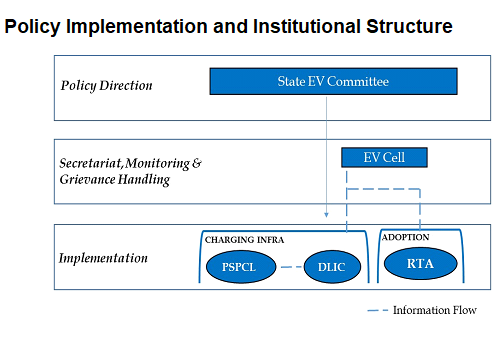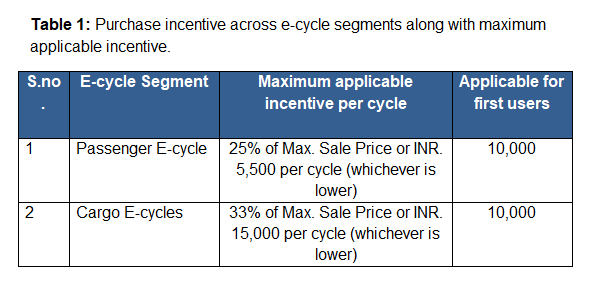
New Delhi: The recently announced five-year Punjab EV policy aims at having at least 25% of annual vehicle registrations to be electric by the end of the policy period.
Recognising the potential of EVs as a long-term sustainable solution, the state government’s dedicated policy is to promote electric vehicles (EVs) and EV component manufacturing and to support EV adoption in the state with a focus on cleaner mobility and employment. The Policy objectives are designed to have direct and indirect impacts on multiple UN Sustainable Development Goals (SDGs).
In line with the notification G.S.R. 525(E) dated 2nd August 2021 in Central Motor Vehicles Rules, 1989, Rule 81; the Policy will also exempt EVs from the payment of fees for the issue or renewal of registration certificate and assignment of the new registration mark.
Besides the registration fees, road tax on all registered Electric Vehicles (or BOVs) registered in Punjab shall be exempted during the policy period.

The Punjab EV policy valid for 5 years from the date of notification will make a detailed review annually. The incentives shall be extended only for the policy period unless otherwise mentioned/notified. The Department of Transport may modify the policy period or any other clauses in this policy with suitable notifications.
The policy will help to:
- Bring about a reduction in vehicular emissions by end of the policy
- Promote the creation of public and private EV charging infrastructure in the state.
- Establish Punjab as a favored destination for manufacturing electric vehicles, components, and batteries.
- Develop into an R&D hub in electric vehicles led by a Centre of Excellence (CoE).
- Enable job creation and introduce vocationally (skilling and up-skilling) and academic training programs for catering to the human resource needs of the EV ecosystem.
- Minimize damage to the environment by promoting recycling and reuse of discarded batteries.
Target cities
The state recognizes the need for promoting cleaner mobility considering the high level of vehicular emissions in major cities- Ludhiana, Jalandhar, Patiala, Amritsar and Bhatinda that contribute to more than 50% of vehicular emissions in the State. These cities shall be collectively referred to as ‘Target Cities’ under this policy.
The most emitting vehicle segments in these cities are buses, taxis, LCVs, 3W and 2W. EV adoption in these segments would maximize the reduction in vehicular emissions. The government of Punjab recognizes that catalyzing adoption in these segments would require incentives toward making EVs cost-competitive and developing adequate charging infrastructure. Hence, this policy focuses on driving adoption of two-wheelers through fiscal incentives, supporting the adoption of electric vehicles for the public, shared, and goods transport (buses, taxis, LCVs and 3W), and creating adequate provisions for EV charging infrastructure.
E-two-wheelers: More than three-fourths (76%) of new vehicle registrations in the state comprise of 2Ws (motorcycles, mopeds, and scooters) during 2013-19. This policy aims to increase the share of e-2Ws significantly to reach 25% of new sales over the policy period.
To promote the adoption of EVs in last-mile delivery services, commercial fleet & delivery companies will be encouraged to achieve a maximum transition towards electric in ‘target cities’ in a phased manner.
In addition to the incentives under the FAME phase-II scheme, a purchase incentive of INR. 3,000 per kWh of battery capacity shall be provided per vehicle, subject to a maximum incentive of INR. 10,000/- per vehicle to the first 1,00,000 registered owners of electric two-wheelers.
E-cycles: The state has been the leading producer and exporter of cycles in the country with over 10 million units produced annually. The most recent iteration of the traditional cycle is the electric bicycle (e-cycle) which aims at reducing manual labour and has the potential to transform the micro-mobility segment. The recent announcement of the Govt. of India to extend the Performance Linked Incentive (PLI) to e-cycles will provide the much-needed thrust to the sector.
To promote the adoption of e-cycles, the Policy shall provide purchase incentives to e-cycles in the state, subject to e-cycles fulfilling the performance and eligibility criteria like a speed limit of 25km/hr, unladen weight (excluding battery weight) of the vehicles should not exceed 60kg, minimum range of 20 km for e-cycle (passenger) and 40 km for e-cycle (cargo), and the e-cycles are powered by an advanced battery (as per FAME-II)

E-3W- Electric Autos (L5M category vehicles): The total number of passenger 3Ws sold during the period between FY14 and FY21 was 36,839 in Punjab, of which more than 75% fleet is diesel-based. This scenario presents an attractive opportunity to leapfrog from diesel autos to e-autos. This policy aims to increase the share of e-autos significantly to reach 25% of new sales over the policy duration period in the target cities.
E-autos will be given preference for fresh permits in ‘target cities’. Fleet owners will be allowed to obtain and hold e-auto permits subject to guidelines issued by the Department of Transport, Government of Punjab.
In addition to the incentives under the FAME phase-II scheme, a purchase incentive of INR. 3,000 per kWh of battery capacity shall be provided per vehicle, subject to a maximum incentive of INR. 30,000/- per vehicle to the first 10,000 registered owners of electric auto-rickshaw (e-auto).
E- Rickshaws & E-Carts: The number of registered e-rickshaws sales during the period FY’14-21 was 2548. However, this number seems less compared to the visibility of e-rickshaws in the state. This may be because of many these vehicles are not registered.
In addition to the incentives under the FAME phase-II scheme, a purchase incentive of INR. 3,000 per kWh of battery capacity shall be provided per vehicle, subject to a maximum incentive of INR. 30,000/- per vehicle to the first 10,000 registered owners of e-rickshaw.
The purchase incentive on e-rickshaw will be available for individual purchasers only, and for one E-rickshaw per individual.
A purchase incentive of INR. 3,000 per kWh of battery capacity shall be provided per vehicle, subject to a maximum incentive of INR. 30,000/- per vehicle to the first 5,000 registered owners of e-cart.
Fleet owners shall be allowed to avail the purchase incentive available on e-carts under this policy.
Electric Light Commercial Vehicles (L5N and N1 category): Light commercial vehicles used as goods carriers are useful for low-capacity, short-haul deliveries in congested areas of the city. The policy recognizes their importance and shall seek to incentivize rapid electrification of this vehicle segment.
A purchase incentive of INR. 3,000 per kWh of battery capacity shall be provided to the first 5,000 registered owners of e-LCV (L5N and N1 category vehicle) subject to a maximum incentive of INR. 30,000/- per L5N category vehicle, and a maximum incentive of INR. 50,000/- per N1 category vehicle.
The applicable purchase incentive of INR. 5,000 per kWh of battery capacity (not exceeding INR. 50,000 per vehicle) shall be reserved for the first 2,500 garbage collection vehicles (excluding vehicles applicable for the incentive under 3.1.5.1); these vehicles could be of L5N and N1 categories.
Commercial fleet businesses will be encouraged to achieve a maximum transition towards electric vehicles through the purchase incentive in ‘target cities’ in a phased manner.
Buses: Currently, almost 90% of the bus fleet in Punjab is diesel-based. The policy shall focus on progressively replacing 25% of the bus fleet operating in Punjab to eliminate old buses in the coming 3 years. Department of Transport would identify: High Volume inter-city bus routes to be considered for transition to EV on priority; City Bus fleet within target cities to be considered for transition to EV; PUNBUS/ PRTC would be encouraged to procure/operate electric buses; Private Bus Operators would be encouraged to operate electric buses on identified routes; The state will endeavour to participate in any/all e-bus aggregation schemes under the Govt. of India’s FAME phase-II scheme.
“The Punjab Government’s move to offer a purchase incentive of INR. 3000 per kWh (Max. incentive of INR. 10,000 per vehicle) of battery capacity per vehicle to the first 1,00,000 buyers of EV 2-wheeler and incentive of INR. 3000 per kWh (Max. incentive of INR. 30,000 per vehicle) to the first 10,000 registered electric auto rickshaw is an encouraging step for the sector. Besides the government has provided similar benefits to light commercial vehicles (L5N and N1 Category) which will pave the way to make India the number one EV Market,” Uday Narang, Founder, OSM, an EV manufacturing company, said.
“We have recently announced the setting up of a manufacturing facility of retrofit (into Electric Vehicles) in Mohali, Punjab. We promise to introduce more and more investment and products in the state,” he said.
Also Read:

